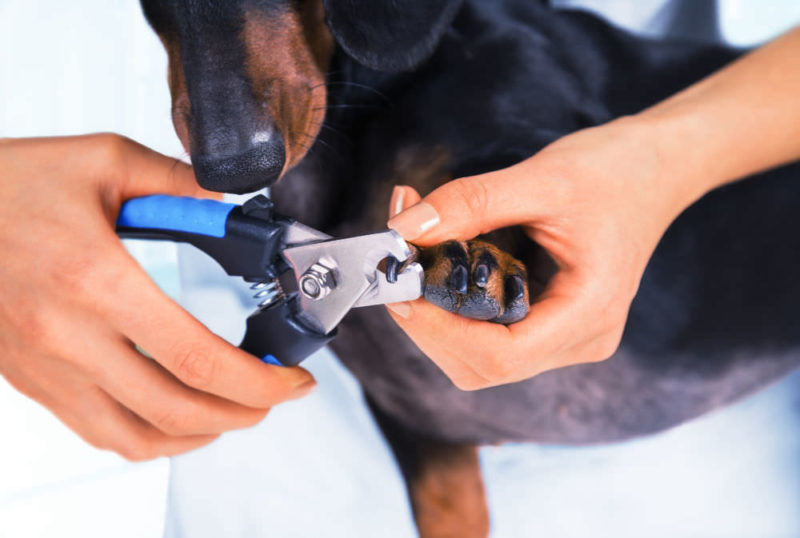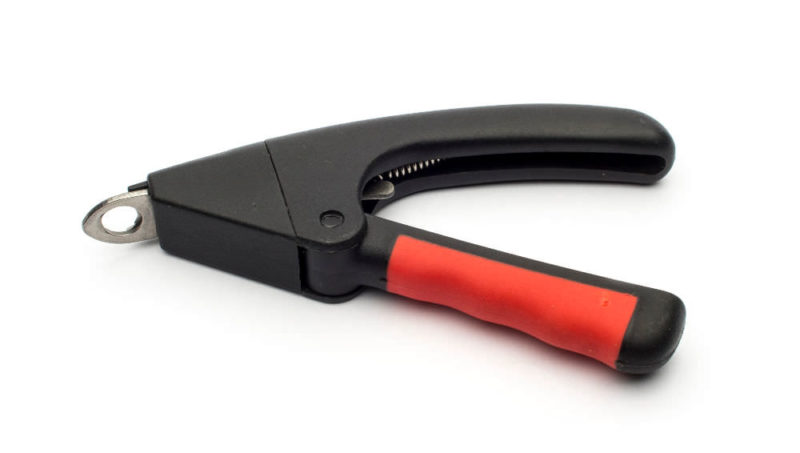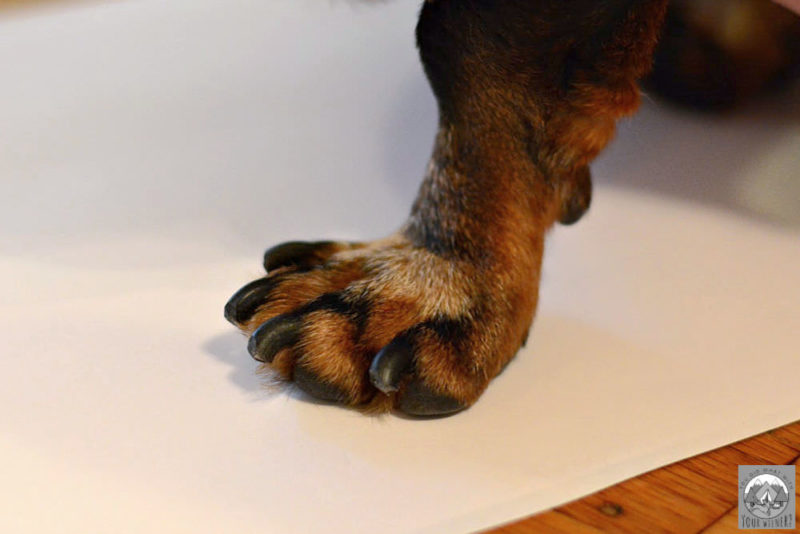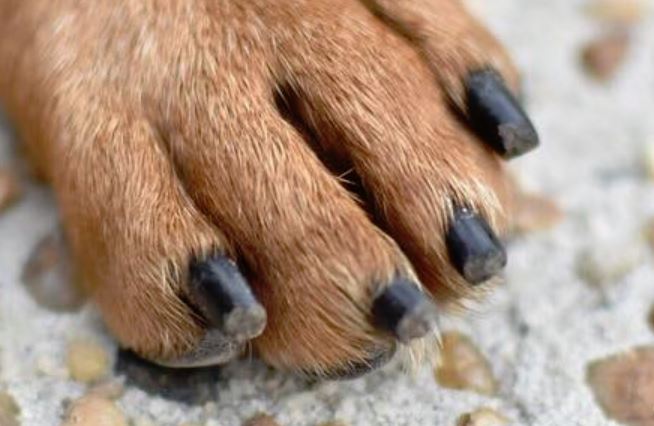This article is a case of do what I say, not what I do because I’ve made a lot of mistakes when it comes to trimming my Dachshund’s nails.
For the most part, their nails are ok but Gretel has nails that are a bit too long.
It’s a long story but, in short, she has back issues and, despite working with her for years, she fights me to the point I worry I will injure her so I have to take her somewhere to get it done. I can’t take her as often as I would like (her nails grow fast so it would be about every 10 days).
Summit is my first dog I got as a puppy. I worked with her for a year and have finally got to a place that she will let me trim her nails without too much protest.
This video shows what was key to her finally letting me do it.
Clearly, I’m no nail trimming expert. However, I get how important it is to keep a Dachshund’s nails a proper length and want to see you be successful.
So, to provide some information about why it’s important not to let your dog’s nails get too long, and to give some tips for trimming a dog’s nails successfully, I’m going to turn it over to my dog-nail-expert friend Stephanie.
What Makes Her an Expert on Trimming Dog Nails?
Stephanie owns dogs that are the size of about 20 miniature Dachshunds but cutting dog nails is a universal struggle whether you are the proud owner of a Dachshund, a Labrador, or a Mastiff.
She is the award-winning blogger of BigDogMom.com and founder of the Dog Nailpro Method, with decades of experience as a dog owner, over 30 years of which has been devoted to health, nutrition, and behavior of dogs.
Method, with decades of experience as a dog owner, over 30 years of which has been devoted to health, nutrition, and behavior of dogs.
Backed by a BS in Microbiology, an MBA, and a passion for writing and big dogs, Big Dog Mom is a purpose-driven brand with a mission to empower, educate and inspire large and giant breed dog owners through outstanding content, useful resources and actionable information.
is a purpose-driven brand with a mission to empower, educate and inspire large and giant breed dog owners through outstanding content, useful resources and actionable information.
Stephanie proudly shares her life with her husband, two children, and the inspiration for Big Dog Mom , her two Mastiffs, Junior and Sulley.
, her two Mastiffs, Junior and Sulley.
5 Mistakes Dog Owners Make When Cutting Dog Nails
As dog owners, we share the desire to keep our dogs happy, healthy, and injury-free, yet dog nails tend to be the one area where we often lack skill and confidence to maintain them properly.
Until now….
One of the best ways to learn how to master a new skill or accomplish a seemingly impossible goal (like getting your dog to LOVE nail trims) is to learn what not to do.
Here are some of the biggest don’ts.



1) Use the wrong or ineffective tool
Whether you are using a traditional nail clipper or a Dremel (grinder) for cutting your dog’s nails, there are aspects to each that you need to consider before putting tool to toenail.
First, most dog owners don’t realize you need to sharpen your nail clipper regularly. This applies to both the scissors style clipper as well as the guillotine style.
A sharp blade ensures you get clean cuts on the nail. When the blade is dull, it increases friction on the nail causing more pressure to be applied and perceived by your dog.
The sharpness of the blade also affects how the clipper sounds on the nail when it’s cutting. What may be imperceptible to you, is heard loud and clear to your dog.
Even tiny changes can make a difference.
Dremels are no different in regard to maintenance.
If you are using a sanding disc, you need to make sure you are replacing the sanding bands on the drum as they become worn down and lose their grit.
When a sanding band has lost it’s grit, it becomes much more difficult and less efficient at sanding the dog nail leading to more time and more discomfort for your dog.
The last thing I will say on this point is to make sure you are using the right tool for your particular dog.
Guillotine-style clippers are usually only appropriate for small and medium size dogs with smaller, softer nails.



Pictured: Guillotine-style clippers Photo Credit: Depositphotos/inWebSite
Scissors-style clippers are more appropriate for dogs with thicker nails and larger dogs.
Also, scissors-style clippers may be easier and more comfortable to use for an owner because you can cut from several different angles.
With proper conditioning and knowledge of how to use it correctly, a Dremel makes a perfect choice for all dog breeds, large and small.
2) Wait too long in between trims or don’t start early
Timing and frequency matter when it comes to trimming dog nails.
Whether you do, or intend to take your dog to a groomer for nail trims, it is imperative that you begin to handle your puppy’s paws and nails right from the beginning.
The foundation you build around paw handling and nail manipulation through proper conditioning will determine future nail cutting success with your dog.
When you put yourself in your puppy’s or dog’s paws, it makes sense. Imagine the first time your owner touches your paws you get a scary instrument chopping part of it off. “Yikes!”
On the contrary, when you slowly condition your puppy or dog to love having paws touched and played with, you are building a solid foundation for then conditioning them to love the nail clipper or Dremel in the future.
In addition, if you take long breaks in between nail trims, you will find that your dog seemingly forgets nail trims can be fun and enjoyable.
Some dog owners will tell me, “I don’t understand. It’s like my dog doesn’t know what the nail clipper is even though I’ve cut his nails many times in the past.”
The mistake many owners make is waiting too long in between nail cutting sessions. This is a mistake for three big reasons:
Frequency Required for a Conditioned Response
Frequency of conditioning is what solidifies a conditioned response.
With the method I teach, nail sessions are frequent and varied in order to properly condition the dog to loving having nails cut.
Put simply, every time the dog sees or experiences the nail clipper or Dremel, great things happen.
The more frequently you are sending that message, the more solidly you are able to affect the emotion of the dog.
Frequency Puts Pressure on the Quick
When done correctly, cutting dog nails more often puts pressure on the quick causing it to recede and the nail to shorten over time.
Waiting too long in between cuts allows that quick to grow longer and longer with the length of the nail, compounding the challenge of not hitting it during trims.
And we all know what happens when you hit the quick… bleeding and pain.
Hitting the quick is not the end of the world, but we try to avoid it if we can.



Frequency Creates a Habit and Priority
Perhaps you’ve heard the saying, “What gets scheduled, gets done.”
When cutting your dog’s nails is a priority, it gets done.
If your dog’s nails are already at the proper length, then I recommend putting a nail session on your calendar once a week.
Consider this time as an opportunity to not only maintain your dog’s nail length, but to further the personal and emotional connection you have with your dog.
If your Dachshund’s nails are too long, you may need to schedule them to be trimmed more frequently over a few week (or couple month) period to get them to the proper length.
3) Never cut or condition in between trips to the groomer
This is one of the biggest fatal flaws most dog owners make when it comes to cutting dog nails.
They expect that taking their dog to the groomer once a month is not only enough to maintain proper length nails, but that it is solely the groomer’s responsibility to do it.
Wrong and wrong.
As we discussed above, monthly or less frequent nail sessions are not enough. Not by a long shot.
And I am here to argue that, while dog groomers provide a wonderful service to dog owners, they are NOT responsible for your dog’s nail health.
In Top 7 Most Popular Myths about Cutting Dog Nails – Busted!, I go into much more detail about this, but for the purposes of this post, let me just say this…
Your dog’s nail health is both physical and behavioral. Because of that, it requires, at the very least, a partnership between you and your groomer to effectively maintain them.
My recommendation is to talk with your groomer and map out a plan moving forward that works for both of you.
Perhaps it is you working on the paw handling foundation and conditioning with a nail clipper or Dremel in between visits to the groomer. Several times a week you sit down and make the whole experience with your dog’s paws and nails an amazing experience.
Imagine just doing that a few times in between visits to the groomer how much more comfortable your dog will be when the groomer starts trimming!
4) Letting them get too long
The issue or proper nail length for a dog can be a bit controversial.
People like to make exceptions or excuses as to why their dog’s nails are long.
But how long is too long? And, in what situations is it beneficial for dogs to have long(er) nails?
I will boil it down to these two simple rules first, then we can talk about some breed specific considerations (NOT exceptions).
- Nails should not touch the ground when your dog is standing on level ground, AND
- You should not hear your dog’s nails on the floor when he walks.*
*This applies to ALL breeds of dog with slight grace given to those with very flat paws. For some paws, while achieving goal #1 is possible, #2 may be more difficult. Baby steps, my friends. Every step you take in this direction is better for your dog.
As long as those two criteria are met, the length of your dog’s nails is acceptable.
My preference is for dog nails for nearly all dogs to be much shorter than this for a few reasons.
However, I am willing to accept these two criteria as the minimum standard.
Beyond this length and dogs will suffer from a myriad of serious orthopedic, postural and mobility issues. This is true of dogs of all sizes.
But once the length standards above are met, you may be wondering in what situations longer nails may provide benefit to the dog.
The following are a few very specific situations where length of nail may be of some functional use for the dog.
- A dog who was bred for AND actively used in the field for digging as a means of hunting. For example, a Dachshund, Toy Fox Terrier, or Beagle that is used for hunting and/or tracking.
- A dog who was bred for AND actively traveling in snow covered terrain for long periods of time. For example an Alaskan Malamute or Siberian Husky that is used in sled work.
- A dog who is VERY active hiking on varied terrain. This is NOT a dog who takes a casual hike on the weekends. This is a dog who is active daily on long hikes on terrain in which having slightly longer nails would provide some functional stability and traction.
5) Using force
Despite being listed last, using force is the single most common mistake dog owners make when it comes to cutting their dog’s nails.
To be clear, my definition of force includes any and all of the following:
- Restraining the dog with a leash or collar
- Trapping the dog in a small area so he/she can’t get away
- Physically holding or pinning the dog down
- Coercing the dog into force or restraint with food
It is no wonder why so many people feel the need to force their dog into a nail trim.
Most dogs fear it and have not been shown or conditioned to believe any different. Consequently, the task becomes almost impossible without some sort of restraint.
You may be thinking, “What’s the big deal? I hold my dog, my husband does the trimming. We get the job done.”
Here is the problem…



Photo Credit: Depositphotos/Voyagerix
Increasing amount of force to accomplish the same task
What starts with two people (one giving treats, the other clipping) eventually becomes one pinning the dog down in some way (whether just a paw or full physical force) and the other clipping.
The reason is when force is applied to a dog that is fearful, that fear response is exacerbated.
When force is applied to a dog that fears the clipper or Dremel or the entire process of nail trimming, the fear is reinforced, again, not reframed.
And so, overtime, the dog’s fear response gets worse and worse. Not better.
It makes it an inherently scary process
Another reason force doesn’t work is because nail trimming requires you to use a tool (clipper or Dremel) to cut a part of your dog.
So the process in and of itself is a scary one.
And because most dogs and puppies are never conditioned to these tools properly, they never really learn that these tools can be wonderful things.
Likewise, because the process of cutting nails is not intrinsically rewarding to the dog, it is more difficult, without proper conditioning, to establish a conditional response (i.e. the dog loving the nail trim).
Freedom reflex is powerful!
And lastly, when a dog’s freedom of movement is restricted, this becomes the most powerful driver of their response to desire freedom.
In the book Conditioned Reflexes, Pavlov explains, “The dog was confined with loose loops around his legs but so as to be quite comfortable and free to move about a pace or two. Initially dog would take food, but eventually dog became more and more upset at being restricted. Eventually the dog wouldn’t eat.”
He goes on to say, “…If the animal were not provided with a reflex of protest against boundaries set to its freedom, the smallest obstacle in its path would interfere with the proper fulfillment of its natural functions.”
Here is the point…
Even with food, a dog wants to be free. He needs to be free for his survival (or so he thinks in the case of cutting nails).
If we are restricting our dog’s freedom of movement through leashing or restraining, we are going to have a negative outcome due to the freedom reflex.
That is, if your goal is training your now fearful dog into one who enjoys and looks forward to nail trims.
What do you fear the most about cutting your dog’s nails? What is holding you back? Let me know in the comments below and I would be happy to help!



<!–
–>
source http://www.luckydogsolutions.com/top-5-mistakes-people-make-when-cutting-their-dogs-nails/


No comments:
Post a Comment